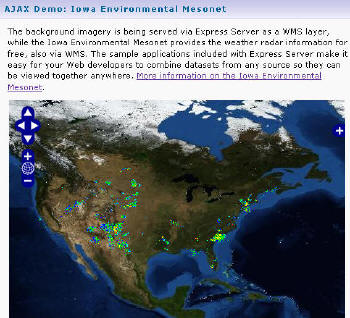Distributor
LizardTech, A Celartem Company
1008 Western Ave. Suite 200
Seattle, WA 98104
206-652-5211
www.lizardtech.com
Pricing: $6,999, includes support
Platforms:
Microsoft Windows 2000 Server and Server 2003
Red Hat Enterprise Linux 3 and 4
Sun Solaris 8, 9 and 10
System requirements for all operating systems:
- 1 Gb RAM (2 Gb recommended)
- Dual processors (recommended)
- 100 Mb of free disk space, plus room for imagery
- Gigabit Ethernet or fiber-optic recommended for remote imagery
- Other system requirements vary based on operating system
LizardTech is primarily known for MrSID, which became a commercial format via the technology transfer program from Los Alamos National Laboratory in the early 1990's. MrSID is a wavelet compression algorithm/format that is used by many organizations to compress, manage and store imagery and other raster data. With MrSID as a starting point, the company has grown products around what users might need to do to manage massive quantities of primarily imagery data, stored in either MrSID or JPEG 2000 (the ISO standard wavelet imaging format). Addressing customer needs is central to the product development sequence and with that theme, you can understand the rest of the product suite.
Express Server followed in 2002. It helps users distribute huge quantities of imagery data to devices over fast or slow networks, but primarily over the Internet, to a wide variety of platforms. Two years later, GeoExpress was released to handle imagery compression and manipulation (reprojections, color balancing, etc.). Spatial Express came out soon after, to help publish imagery data to spatial databases such as Oracle Spatial.
Industries served
Defense and intelligence agencies, primarily in the United States but also overseas, make up LizardTech's main customers for the product suite. The company also has a market among civil federal agencies such as the Bureau of Land Management and the U.S. Geological Survey, a smaller user base in state and local government, and an even smaller one among data providers. LizardTech's sixth version of Express Server addresses the data-pushing demands of these users.
Jon Skiffington, senior product manager for Geospatial Imaging at LizardTech, provided an overview of the upgrades. With version 6, there is greater integration with Spatial Express, which focuses primarily on Oracle. Skiffington said that ï¿1⁄2the key thing about the new release is that it integrates with spatial applications through spatial databases,ï¿1⁄2 and it also supports the OGC's Web Map Service (WMS) specification. In other words, if you have imagery in an Oracle database, your life is now somewhat simpler. You can more easily distribute those data, through products such as ArcIMS or other Web applications that use WMS.
Skiffington also stressed that the new version is better at distributing images faster without additional hardware or bandwidth. It's also better at handling metadata, because it includes tools that interface with GMLJP2 (a standard for adding GML metadata to JPEG 2000).
Demos
The technical details of these kinds of enabling technologies are absolutely critical to those charged with managing the flow of raster data and supporting applications that use those data. To make the impact of the technical details clear LizardTech offers a demonstration site to exhibit Express Server n action. The site includes tours of three Express Server functions:
- View imagery in many different applications
- Distribute large datasets to my end users
- Use high resolution imagery in the field for decision support
 |
My take
There are gigabytes and gigabytes of raster data available - the amount of imagery being added to the world's archives on a daily basis is staggering. Most people don't give a lot of thought to the technical bits and pieces that sit behind the visualization and analyses of these data in support of their use. But without enabling technology tools like those from LizardTech, routine and innovative use of imagery would grind to a halt. Express Server 6 is an upgrade that will bring new tools to its specialized user base which will enhance data distribution and use. End users don't even need to know about the magic that makes their work possible.